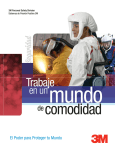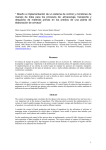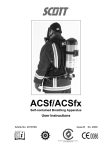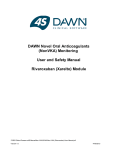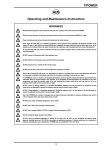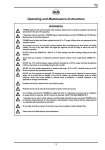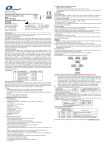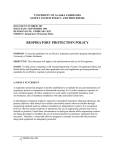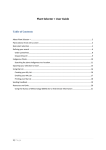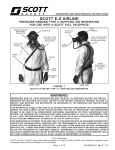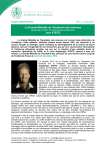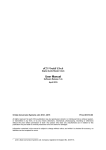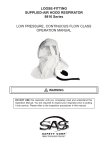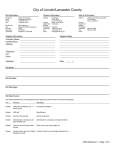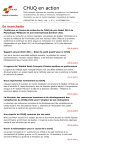Download PAPR user manual - Women`s and Children`s Hospital
Transcript
Jupiter Turbo Unit POWERED AIR PURIFYING RESPIRATOR User Instructions Women’s and Children’s Hospital Infection Control Unit Contents Introduction Page 3 Using the Powered Air Purifying Respirator (PAPR) Page 4 Decontamination of the Powered Air Purifying Respirator Page 5 Routine Maintenance Schedule Page 6 Maintenance of battery Page 7 Airflow Check Page 8 Maintenance of filters Page 8 Calibration of Jupiter Turbo Unit Page 9 References Page 10 Women’s and Children’s Hospital Infection Control Unit Page 2 Jupiter Turbo Unit User Instructions Introduction The purpose of a Powered Air Purifying Respirator (PAPR) is to prevent the inhalation of harmful airborne substances. The PAPR uses a blower to pass contaminated air through a filter that removes the contaminant and supplies the purified air to the inside of a full face piece or a loose fitting hood (Communicable Diseases Network Australia, 2003). The hood covers the head, neck, and upper torso, and includes a neck cuff. Air is delivered by a compressor through a hose leading into the hood. Because the hood is not tight fitting, it is important that sufficient air is provided to maintain a slight positive pressure inside the hood relative to the environment immediately outside the hood. In this way, an outward flow of air from the respirator will prevent contaminants from entering the hood (Occupational Safety and Health Administration, 1998). The JupiterTM PAPR has been tested and meets the requirements of AS/NZS1716 “Respiratory protective devices” when used correctly. The JupiterTM PAPR units at the Women’s and Children’s Hospital each come with an 8 hour battery pack and can be used with a range of filter options. The PAPR units incorporate an electronic control unit which provides an audible and visual warning of low battery and / or low airflow into the head top. Indications for use The JupiterTM PAPR should be used by staff when performing an aerosol generating procedure on a patient that is suspected or has been diagnosed with an airborne transmitted infectious disease that requires a high level of respiratory protection. These diseases include: • Severe Acute Respiratory Syndrome (SARS) • Tuberculosis (TB) • Viral Haemorrhagic Fever An aerosol generating procedure is defined by the CDC as: • Bronchoscopy • Endotracheal intubation • Suctioning • Open abscess irrigation • Autopsy The JupiterTM PAPR should also be worn when a good seal cannot be formed with other protective masks, for example when staff have a growth of beard or sideburns. NOTE: The JupiterTM PAPR should only be used if the staff member is trained in their use. Women’s and Children’s Hospital Infection Control Unit Page 3 Jupiter Turbo Unit User Instructions Using the Powered Air Purifying Respirator (PAPR) PAPR Unit consists of: • • • Belt and PAPR air filter unit with 2 high efficiency particle air (HEPA) filters Breathing tube Orange full head hood or blue half head hood Performance check 1. Ensure that a charged battery is correctly inserted in the PAPR air filter unit. 2. Ensure that the PAPR air filter unit and hood are not visibly damaged. 3. Perform an air flow check prior to first use and then once a shift thereafter. Donning the PAPR A staff member that is familiar with the donning procedure must assist the operator with the donning the PAPR to ensure safety. 1. The operator and assistant must wash or apply alcohol based hand gel to hands. 2. The operator must don a disposable gown / coveralls. The assistant must ensure that all gown ties are secure and that the gown / coverall covers the operators clothing. 3. Operator to adjust the head piece inside the full head hood prior to use. 4. Operator to don a pair of disposable gloves, ensuring that the glove cuffs are pulled over the gown / coverall cuffs. 5. Buckle and adjust the waist belt with the PAPR air filter unit fitted. Ensure a comfortable fit. The assistant will ensure that the gown / coverall has not been displaced. 6. Assistant to connect the breathing tube onto the hood connector and the PAPR air filter unit. Ensure that the locking collar clicks into the locked position. 7. Assistant to turn the PAPR air filter unit on 8. Operator to place hood over their head with the assistants help. Ensure that the hood is placed comfortably and that the shoulder protectors are not gathered. 9. Prior to entering the patient’s room the assistant will ensure that the operator is comfortable and all protective attire is donned appropriately. Removing the PAPR A staff member that is familiar with the removal procedure must assist the operator with the removal of the PAPR to ensure safety. 1. The PAPR will be removed and decontaminated outside of the patient’s room, either in an ante room or directly outside the patient’s room. PAPR MUST NOT be removed in the patient’s room. 2. A staff member must assist the operator in removing the PAPR. The assistant must wear full PPE (personal protective equipment), ie N95 mask, goggles, gown, and gloves. 3. The assistant will turn off the PAPR air filter unit and disconnect the breathing tube from the hood and the PAPR air filter unit. 4. The assistant will unbuckle and remove the waist belt with the PAPR air filter unit fitted. 5. The operator will remove the hood by grasping the sides of the hood and carefully lifting the hood off of their head. 6. Break the waist and neck ties of the disposable gown. Women’s and Children’s Hospital Infection Control Unit Page 4 Jupiter Turbo Unit User Instructions 7. Roll and fold the gown / coverall in on itself (starting from the shoulders) to ensure that contamination of the environment is minimised. 8. Take the gloves off when pulling the sleeves of the gown / coverall over the hands. 9. Dispose of the gown / coverall and gloves. 10. The assistant will then decontaminate the PAPR prior to removing their PPE (refer to “Decontamination of the Jupiter TM Powered Air Purifying Respirator”). 11. After removal and decontamination of the PAPR and PPE the operator and assistant must wash their hands or apply alcohol based hand gel. WARNING The operator must leave the contaminated area immediately if: • • • • The warning light and / or alarm activate. They smell or taste contaminants. They become dizzy or irritation occurs. The system shuts off. • If the integrity of the PAPR or PPE diminishes. Decontamination of the Powered Air Purifying Respirator 1. Disconnect the breathing tube from the hood. 2. Disconnect the other end of breathing tube from the PAPR air filter unit. 3. Remove PAPR air filter unit from the waist belt. Decontamination of the hood 4. Clean all parts of the hood with a cloth dampened with warm water containing a mild detergent. Do not use detergents that contain lanolin or other oils. 5. After cleaning with detergent and water, wipe over the hood with hypo chlorite solution (Miltons solution). Decontamination of the PAPR air filter unit 6. Remove the filter cartridges from the PAPR air filter unit. Do not attempt to clean the filters. 7. Wipe the battery pack with detergent and water. Do not immerse the battery pack. 8. Clean the PAPR air filter unit by wiping down with detergent and water. Do not immerse the PAPR air filter unit. Be careful not to let any of the cleaning solution enter into the PAPR air filter unit. 9. Wipe over all components with hypo chlorite solution (Miltons solution). Decontamination of the breathing tube 10. Cover both ends of the breathing tube. Clean the breathing tube by wiping over with detergent and water. Be careful not to let any of the cleaning solution enter into the hose. 11. Reassemble unit as described in the user instructions. Women’s and Children’s Hospital Infection Control Unit Page 5 Jupiter Turbo Unit User Instructions Routine Maintenance Schedule The JupiterTM PAPR will be housed in the Paediatric Intensive Care Unit (PICU). Routine maintenance will be conducted by the Equipment Nurse (PICU). Maintenance when the Jupiter Turbo Unit is not in use Weekly • Batteries to be charged overnight Monthly • Calibration of the unit Maintenance when the Jupiter Turbo Unit is in use Every Shift • • Conduct airflow check Recharge batteries Weekly • Unused batteries to be charged overnight Monthly • Calibration of the unit Adhoc • • Replace filters when damaged, soiled, or increased breathing resistance occurs Replace filters when expiration period has expired Note: A maintenance log must be kept for each piece of equipment Note: Refer to the Women’s and Children’s and / or the 3M “Jupiter Turbo Unit Users Instructions” for further details. Women’s and Children’s Hospital Infection Control Unit Page 6 Jupiter Turbo Unit User Instructions Maintenance of battery Battery charging 1. The battery must be charged in a safe and clean area. Do not charge battery packs in an enclosed cabinet without ventilation. 2. If a battery feels hot, let it cool for half an hour before charging. 3. Plug the charging cord into the charging port on the side of the battery pack. 4. When the green light is on displayed on the charger, the battery is fully charged and ready for use. 5. A fully discharged battery should be fully charged in approximately 8 hours. 6. The battery should not be left on the charger for more than 7 days. 7. Charge the battery before it is completely discharged. Damage will occur if the battery is completely discharged or “over-discharged”. 8. The battery may be charged at any time during it’s discharge cycle. Battery memory (or voltage depression) is not a significant factor. Battery use log book: At the end of a shift, document in a log book the approximate number of hours that the battery has been in use. When it is near to eight hours, replace the battery and charge the old one. Battery maintenance Without periodic charging, a battery loses approximately 10% of its charge after one week and 20% after one month. 1. Infrequently used batteries (ie unused for >5 days) should be fully charged, initially, and then charged overnight once per week to maintain a full charge. Battery installation 1. After charging, insert the battery into the PAPR battery slot. 2. Slide the battery in all the way until the latch on the back cover of the PAPR unit engages with the corresponding latch on the battery 3. Pull downward on the battery to ensure there is proper engagement. Battery removal 1. Insert thumb between the battery and the latch tongue to disengage the primary latch. 2. Pry fingers between the rib on the battery and the blower housing to disengage the secondary latch. 3. Pull the battery out. Women’s and Children’s Hospital Infection Control Unit Page 7 Jupiter Turbo Unit User Instructions Airflow Check To ensure that the PAPR unit is providing adequate airflow an airflow check must be performed prior to the first use of the PAPR and once per shift thereafter. 1. 2. 3. 4. 5. 6. Ensure that the filters are fitted prior to testing the airflow. Insert a charged battery into the PAPR unit. Ensure that the breathing tube is not connected to the PAPR outlet. Insert the airflow indicator tube (white ball) into the outlet of the PAPR unit. Switch the PAPR unit on and hold vertically. Do not cover the airflow indicator tube. Check that the airflow indicator ball is floating above the pass level marked on the tube. If the ball falls below the pass mark, airflow is insufficient. This may be the result of a battery with a low charge, a clogged filter or other malfunctions. (Refer to user manual) Maintenance of filters Filter installation` 1. Ensure that the appropriate type of filter is selected for the procedure. 2. Screw a filter into the each of the two threaded inlets until the raised stud on the back of the filter engages with the locking ribs on the blower housing. 3. If the filter feels loose check for correct gasket installation and cracks in the plastic in the threaded inlet. Filter life 1. The filter life of the filters will depend upon several factors: • The flow rate • The specific type and concentration of the contaminants • Environmental conditions such as humidity and temperature 2. Do not use filters beyond their expiration date. 3. Both filters must be replaced if they become damaged, soiled or if increased breathing resistance occurs. Women’s and Children’s Hospital Infection Control Unit Page 8 Jupiter Turbo Unit User Instructions Calibration of Jupiter Turbo Unit The Jupiter turbo will be calibrated initially at the Respirator Service Centre before despatch. However, over time, you may need to recalibrate the turbo, especially if the low flow alarm is occurring even with new or near new filters. 3M recommends calibration should be done monthly to prevent any issues with flow alarms. The calibration procedure is as follows: NOTE: Calibration should be undertaken without any filters fitted, using a fully charged battery. Find the calibration tube (Part No. 021-14-11) i.e. the clear tube with black ball inside NOT the tube with the white ball. The tube with the white ball is an airflow indicator and is used to check airflow – this process is explained in the Jupiter User Manual Section 8.1. Insert the calibration tube (black ball) into the air outlet of turbo unit. See diagram below. To start calibration, hold the switch button and a single beep will be heard. Keep the button depressed during the whole calibration process. After 3 seconds, a second beep will sound. The LED display on startup will initially show the following lights: Women’s and Children’s Hospital Infection Control Unit Page 9 Jupiter Turbo Unit User Instructions After the 3 seconds it will display: This display indicates the unit is in calibration mode. The fan speed will gradually increase. Release the switch when the black ball is above the pass mark on the tube as shown in the diagram above. This sets the calibration point and completes the procedure. Any turbo unit out of calibration will have a low flow alarm that cannot be resolved ie an “out of calibration” turbo with new filters or even no filters fitted will still alarm showing low flow. The display for low flow is: If an airflow alarm problem persists after calibration, please contact your local 3M representative or the 3M TechAssist hotline on 1800 024 464. References 3M. “JupiterTM Powered Air Purifying Respirator – User Instructions”, 3M, Version 0502 Communicable Diseases Network Australia. “Interim Australian Infection Control Guidelines for Severe Acute Respiratory Syndrome (SARS)”; Section 5 Appendices, May 2003 Infection Control Unit, “How to use powered air purifying respirator (PAPR)”, Princess Margaret Hospital, May 2003 Infection Control Unit, “Use of the powered air purifying respirator (PAPR) Jupiter Unit (3M)”, Sir Charles Gairdner Hospital, May 2003 Infection Control Unit and Medical Illustration, “Use of PAPR: Powered Air-purifying Particulate Respirator”, Fremantle Hospital and Health Service, 2003 Occupational Safety and Health Administration (OSHA). “OSHA Technical Manual”. U.S.Department of Labor. Section 8, Chapter 2, May 1998 Women’s and Children’s Hospital Instructions Infection Control Unit Page 10 Jupiter Turbo Unit User










